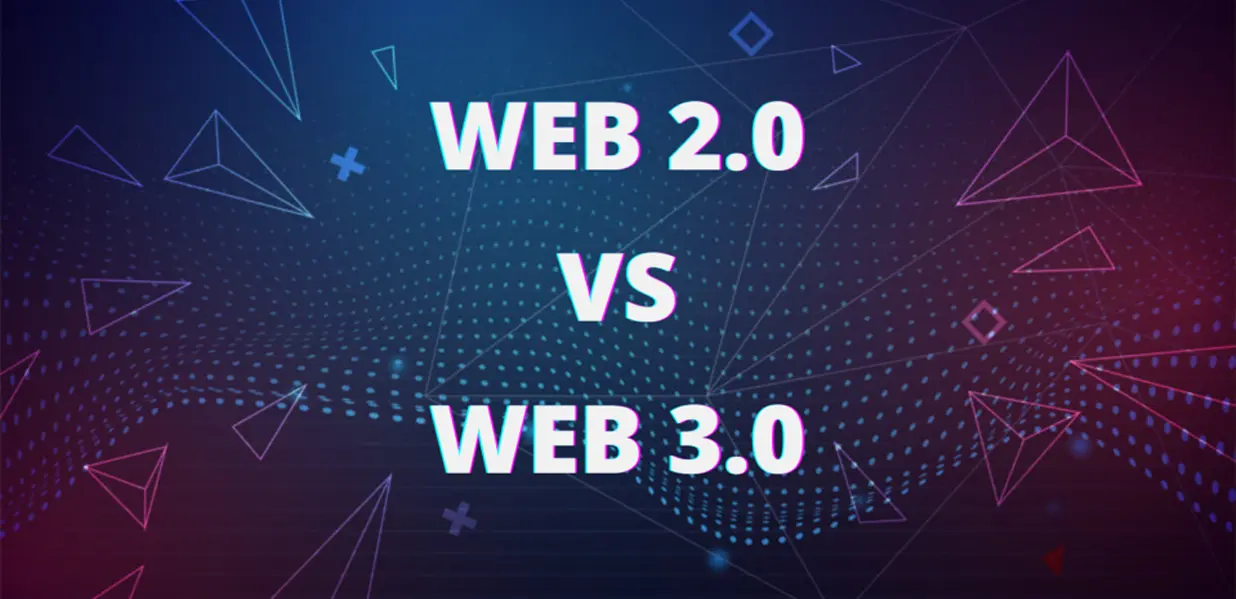


 December 20, 2023
December 20, 2023
 0
0
 benefits of Web3, difference between Web2 & Web3, Misconceptions about Web 3.0, Web 3.0, Web 3.0 vs Web 2.0, Web2.0
benefits of Web3, difference between Web2 & Web3, Misconceptions about Web 3.0, Web 3.0, Web 3.0 vs Web 2.0, Web2.0
The transition from Web 2.0 to Web 3.0 implies a paradigm change with far-reaching ramifications for enterprises in a variety of industries. This blog tries to explore Web 3.0 vs Web 2.0, emphasizing their different qualities, technological underpinnings, and potential impact on business models.
Web 2.0, also known as the participative social web, ushered in a new era of user-generated content, interactivity, and collaboration on the internet, spawning social networking sites, blogs, and e-commerce platforms. Web 3.0, also known as the semantic web, on the other hand, offers an enhanced layer of data interpretation, interoperability, and user empowerment by using technologies such as blockchain, artificial intelligence, and decentralized networks.
Understanding the transition from Web 2.0 to Web 3.0 is critical for businesses seeking to remain competitive in a digital economy. This blog will analyze the key differences between these two web stages, as well as their implications for businesses and how organizations might adapt and survive in the age of Web 3.0.
Web 2.0, a term coined in the early 2000s, refers to the World Wide Web's second generation. It represents a shift away from the static, information-based web (Web 1.0) and toward a dynamic, interactive platform.
Web 3.0, also known as the semantic web or the decentralized web, is a developing concept that represents the internet's future generation.
| Criteria | Web 3.0 | Web 2.0 |
| Centralization vs. Decentralization | Web 3.0 emphasizes decentralization by distributing data across several nodes using technologies such as blockchain. This lessens dependency on central authority while also attempting to improve security and privacy. | Web 2.0 is highly centralized, which means that data and content are hosted on servers owned and managed by centralized institutions or businesses. Because of this centralization, a few large firms hold vast amounts of customer data. |
| Data Privacy and Ownership | Proposes a model in which people have more control and ownership over their data. Blockchain and cryptographic protocols enable secure, private data exchanges and transactions. | In general, users do not own their data. Service providers, such as social media platforms, collect and control user data, which is frequently used for advertising and other commercial purposes. |
| Integration and interoperability | Aims for more interoperability, to build a more linked and seamless web in which data and assets may be readily accessed and traded across several platforms and applications. | While Web 2.0 provides some interoperability, it is frequently limited to certain platforms or services, and data silos are widespread. |
| Infrastructure and technology | Makes use of cutting-edge technology like blockchain, artificial intelligence, and the Internet of Things (IoT). These technologies enable smarter, more secure, and autonomous web interactions. | Web 2.0 is characterized by the usage of centralized databases and a server-client architecture. AJAX and HTML5 improve user experience but rely on old web infrastructure. |
| Business Model | Web 3.0 introduces new economic models such as tokenization and decentralized finance (DeFi), allowing people to own and benefit from the platforms and services they use. | Web 2.0 economic models are mostly centered on advertising and data monetization, with user data used to target advertisements. |
| Content and User Experience | AI is used to create a more personalized and intelligent web experience. Content can become more dynamic, context-aware, and personalized based on user preferences. | Web 2.0 is characterized by a focus on user-generated content and social networking. The user experience is participatory, yet platform providers have a considerable amount of influence over it. |
Web 3.0 has various potential benefits that represent a major advancement over Web 2.0 capabilities. These advantages originate from its underlying technologies, such as blockchain, artificial intelligence (AI), and the Internet of Things (IoT), and address many of the shortcomings of present web infrastructure:
Addressing misconceptions about Web 3.0 is crucial for a clear understanding of its potential impact and limitations. Here are some common misconceptions:
Reality: While Web 3.0 stresses decentralization, it does not eliminate the need for trust fully. Certain components, such as smart contract integrity and blockchain network governance, still necessitate a measure of confidence among participants. In fact, complete decentralization may not be possible, therefore hybrid solutions mixing decentralized and centralized parts are prevalent.
Reality: While Web 3.0 technologies such as blockchain improve data security and user privacy, they are not without flaws. Data privacy threats can be posed by issues such as data leaking in smart contracts, potential vulnerabilities in decentralized apps (DApps), and the public nature of some blockchain transactions.
Reality: One of Web 3.0's goals is to give consumers more control over their personal data, potentially limiting advertisers' ability to access it without consent. However, this does not exclude the use of personal data for advertising purposes entirely. New approaches that allow people to willingly exchange data with advertising under more controlled and transparent settings may emerge.
Reality: Ad removal and tracking are not intrinsic features of Web 3.0. While Web 3.0 may alter how advertisements are presented and tracking is carried out, these tactics may still remain. The fundamental distinction is in how user agreement is sought and data is handled, with a potential shift toward more user-centric and privacy-conscious ways.
Deciding whether Web 3.0 or Web 2.0 is better for your business depends on various factors unique to your business context, including industry-specific needs, target audience, technological infrastructure, and strategic objectives. Here's a comparison to aid in making an informed decision:
The change from Web 2.0 to Web 3.0 marks a substantial transformation in how businesses function, communicate with customers, and manage data. For organizations, here's a summary of how Web 3.0 will differ from Web 2.0:
With its expertise in cutting-edge digital solutions, Infiniticube can be a valuable ally in converting your company into the Web 3.0 age. We can help you integrate innovative technologies into your existing business model by utilizing our expertise in blockchain technology, AI, and decentralized apps (DApps).
This connection will not only improve data security and user privacy but will also pave the way for new revenue streams via tokenization and decentralized financing (DeFi).
Furthermore, our emphasis on designing user-centric and interoperable technologies enables a smooth transition, allowing your company to quickly adapt to the evolving digital landscape. We are a perfect partner for businesses looking to embrace the benefits and challenges of Web 3.0 due to its holistic approach, which includes strategic planning, implementation, and support.
Contact us today to explore how our expertise in Web 3.0 technologies can transform your business, enhance your digital presence, and unlock new opportunities in the decentralized web era. Schedule a consultation and take the first step towards a revolutionary digital transformation!
How can businesses prepare for the Web 3.0 transition?
Businesses may prepare by learning about blockchain, decentralized applications, and artificial intelligence. They should also investigate how decentralized models can affect their operations and pursue collaborations with Web 3.0 technology firms.
Is there a regulatory issue with Web 3.0?
Yes. Web 3.0's decentralized and blockchain-based structure poses regulatory issues, particularly in areas such as cryptocurrency, digital assets, and user data management.
How will the Web 3.0 user experience differ?
Users should expect more data management, tailored and intelligent interactions via AI, and even a more seamless experience across several platforms and devices.
What role does artificial intelligence play in Web 3.0?
AI is critical in Web 3.0 for data analysis, personalization, and offering intelligent and efficient user interactions by exploiting the web's linked and semantic nature.
Can Web 2.0 and Web 3.0 technology coexist?
Yes, many firms are likely to take a hybrid approach, taking advantage of Web 2.0's stability and user base while progressively adopting Web 3.0 capabilities where they bring value.

Hey! I'm Balbir Singh, seasoned digital marketer at Infiniticube Services with 5 years of industry expertise in driving online growth and engagement. I specialize in creating strategic and ROI-driven campaigns across SEO, SEM, social media, PPC, and content marketing. Passionate about staying ahead of trends and algorithms, I'm dedicated to maximizing brand visibility and conversions.
Our newsletter is finely tuned to your interests, offering insights into AI-powered solutions, blockchain advancements, and more.
Subscribe now to stay informed and at the forefront of industry developments.